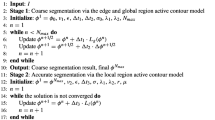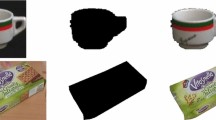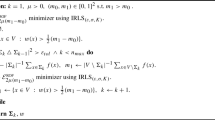Abstract
We attempt to unify several approaches to image segmentation in early vision under a common framework. The Bayesian approach is very attractive since: (i) it enables the assumptions used to be explicitly stated in the probability distributions, and (ii) it can be extended to deal with most other problems in early vision. Here, we consider the Markov random field formalism, a special case of the Bayesian approach, in which the probability distributions are specified by an energy function.
We show that: (i) our discrete formulations for the energy function is closely related to the continuous formulation; (ii) by using the mean field (MF) theory approach, introduced by Geiger and Girosi [1991], several previous attempts to solve these energy functions are effectively equivalent; (iii) by varying the parameters of the energy functions we can obtain connections to nonlinear diffusion and minimal description length approaches to image segmentation; and (iv) simple modifications to the energy can give a direct relation to robust statistics or can encourage hysteresis and nonmaximum suppression.
Similar content being viewed by others
References
Ambrosio, L. 1988. Variational problems in SBV. Technical Report Lectures Notes, M.I.T., Cambridge, MA
Berger, J.O. 1985. Statistical Decision Theory and Bayesian Analysis. Springer-Verlag: New York.
Blake, A., and Zisserman, A. 1987. Visual Reconstruction. MIT Press: Cambridge, MA.
Canny, J.F. 1986. A computational approach to edge detection. IEEE Trans. Patt. Anal. Mach. Intell., PAMI8(6): 679–698.
Chou, P.B., and Brown, C.M. 1988. Multimodal reconstruction and segmentation with Markov random fields and HCF optimization. Proc. Image Underst. Work. Morgan Kaufmann, San Mateo, CA. Cambridge, MA, February, pp. 214–221.
Durbin, R., and Willshaw, D.J. 1987. An analogue approach to the travelling salesman problem using an elastic net method. Nature, 326: 689–691.
Gamble, E.B., and Poggio, T. 1987. Visual integration and detection of discontinuities: The key role of intensity edges. A.I. Memo No. 970, Artificial Intelligence Laboratory, Massachusetts Institute of Technology, Cambridge, MA, October.
Geiger, D., and Girosi, F. 1991. Parallel and deterministic algorithms for MRFs: Surface reconstruction and integration. PAMI-13(5), May. Also A.I. Memo No. 1114, Artificial Intelligence Laboratory, Massachusetts Institute of Technology, Cambridge MA.
Geiger, D., and Pereira, R.M. 1990. On intelligent sparse data. IEEE 7th Israeli Symp. Artif. Intell. Comput. Vision, Haifa, Israel.
Geiger, D., and Poggio, T. 1987. An optimal scale for edge detection. 10th Intern. Joint Conf. Artif Intell., Milan, August.
Geman, S., and Geman, D. 1984. Stochastic relaxation, Gibbs distributions, and the Bayesian restoration of images. IEEE Trans. Patt. Anal. Mach. Intell. PAMI6: 721–741.
Geman, S., and McClure, D.E. 1987. Statistical methods for tomographic image reconstruction. Proc. 46th Session of the ISI, Bulletin of ISI.
Girosi, F., Poggio, T., and Caprile, B. 1989. Extensions of a theory of networks for approximation and learning: Outliers and negative examples. Technical Report, Artificial Intelligence Laboratory, Massachusetts Institute of Technology, Cambridge, MA.
Graham, R.E. 1962. Snow removal: A noise-stripping process for TV signals. TRE Trans. Inform. Theory 9: 129–144.
Grimson, W.E.L., and Pavlidis, T. 1985. Discontinuity detection for visual surface reconstruction. Comput. Vision, Graph. Image Process. 30: 316–330.
Hallinan, P.W., and Mumford, D. 1990. In preparation.
Hopfield, J.J. 1984. Neurons with graded response have collective computational properties like those of two-state neurons. Proc. Nat. Acad. Sci. 81: 3088–3092.
Hopfield, J.J., and Tank, D. 1985. Neural computation of decision in optimization problems. Biological Cybernetics 52: 141–152.
Huber, R.J. 1981. Robust Statisties. John Wiley: New York.
Keeler, K.C. 1990. Map representation and optimal encoding for image segmentation. Ph.D. thesis.
Kirkpatrick, S., Gelatt, C.D., and Vecchi, M.P. 1983. Optimization by simulated annealing. Science 220: 219–227.
Koch, C., Marroquin, C., and Yuille, A. 1985. Analog ‘neuronal’ networks in early vision. Proc. Natl. Acad. Sci. 83: 4263–4267.
Leclerc, Y.G. 1988. Constructing simple stable descriptions for image partitioning. Proc. Image Underst. Work. 1: 365–382.
Lee, D., and Pavlidis, T. 1987. One-dimensional regularization with discontinuities. Proc 1st Intern. Conf. Comput. Vision, London, Jurie.
Marroquin, J.L. 1985. Probabilistic solution of inverse problems. Ph.D. thesis, Massachusetts Institute of Technology, Cambridge, MA.
Marroquin, J.L. 1987. Deterministic Bayesian estimation of Markovian random fields with applications to computational vision. Proc. 1st Intern. Conf. Comput. Vision, London, England, June.
Marroquin, J.L., Mitter, S., and Poggio, T. 1985. Probabilistic solution of ill-posed problems in computational vision. In L. Baumann, ed. Proc. Image Underst. Work., Scientific Applications International Corporation, McLean, VA, August, pp. 293–309.
McKendall, R., and Mintz, M. 1989. Robust Fusion of Location Information. Preprint. Department of Computer and Information Science, University of Pennsylvania, Philadelphia, PA.
Metropolis, N., Rosenbluth, A., Rosenbluth, M., Teller, A., and Teller, E. 1953. Equation of state calculations by fast computing machines. J. Phys. Chem. 21: 1087.
Mumford, D., and Shah, J. 1985. Boundary detection by minimizing functionals. Proc. IEEE Conf. Comput. Vision Patt. Recog., San Francisco, CA.
Nitzberg, M., and Shiota, T. 1990. Nonlinear image smoothing with edge and corner enhancement. Technical Report 90-2, Harvard Robotics Laboratory.
Nordstrom, N.K. 1990. Variational edge detection. Ph.D. thesis, University of California at Berkeley.
Parisi, G. 1988 Statistical Field Theory. Addison-Wesley: Reading MA.
Pavlidis, T. 1986. A critical survey of image analysis methods. Proc. 8th Intern. Conf. Pott. Recog., Paris.
Perona, P., and Malik, J. 1987. Scale space and edge detection using anisotropic diffusion. Proc. 5th IEEE Work. Comput. vision, Miami.
Richardson, T. 1990. Department of electrical engineering and computer science. Ph.D. thesis, Massachusetts Institute of Technology, Cambridge MA.
Rissanen, J. 1978. Modeling by shortest data deseription. Automatica 14: 465–471.
Terzopoulos, d. 1986. Regularization of inverse visual problems involving discontinuities. IEEE Trans. Patt. Anal. Mach. Intell. PAMI8: 413–424.
Wasserstrom, E. 1973. Numeral solutions by the continuation method. SIAM Review 15: 89–119.
Witkin, A.P., 1983. Scale-space filtering. Proc. 8th Intern. Joint Conf. Artif. Intell., Karlsruhe, pp. 1019–1022.
Yuille, A.L. 1987. Energy functions for early vision and analog networks. A.I. Memo No. 987, Artificial Intelligence Laboratory, Massachusetts Institute of Technology, Cambridge, MA, October.
Yuille, A.L., and Poggio, T. 1983. Fingerprint theorems for zero crossings. A.I. Memo No. 730, Artificial Intelligence Laboratory, Massachusetts Institute of Technology, Cambridge, MA.
Yuille, A.L., Yang, T., and Geiger, D. 1990. Towards a theory of transparency. Harvard Robot. Lab. Tech. Report (in preparation), Harvard University, Cambridge MA.
Author information
Authors and Affiliations
Rights and permissions
About this article
Cite this article
Geiger, D., Yuille, A. A common framework for image segmentation. Int J Comput Vision 6, 227–243 (1991). https://doi.org/10.1007/BF00115697
Received:
Revised:
Issue Date:
DOI: https://doi.org/10.1007/BF00115697




